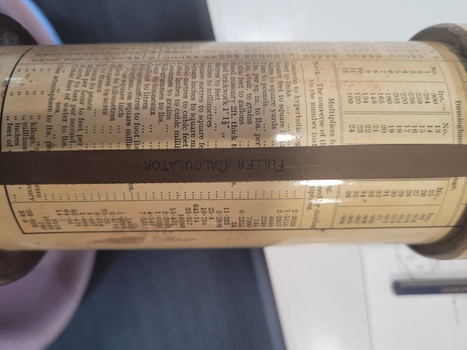Historical information
The Fuller cylindrical slide rule, is a cylindrical slide rule with a helical main scale taking 50 turns around the cylinder. This creates an instrument of considerable precision – it is equivalent to a traditional slide rule 25.40 metres (1,000 inches) long. It was invented in 1878 by George Fuller, professor of engineering at Queen's University Belfast, and despite its size and price it remained on the market for nearly a century because it outperformed nearly all other slide rules. He patented it in Britain in 1878, described it in a journal in 1879 and in that year he also patented it the United States, depositing a patent model.
As with other slide rules, the Fuller is limited to calculations based on multiplication and division with additional scales allowing for trigonometrical and exponential functions. The mechanical calculators produced in the same era were generally restricted to addition and subtraction with only advanced versions, like the Arithmometer, able to multiply and divide. Even these advanced machines could not perform trigonometry or exponentiation and they were bigger, heavier and much more expensive than the Fuller. In the mid-twentieth century the handheld Curta mechanical calculator became available which also competed in convenience and price. However, for scientific calculations the Fuller remained viable until 1973 when it was made obsolete by the HP-35 handheld scientific electronic calculator.
Fuller's calculators were manufactured by the scientific instrument maker W.F. Stanley & Co. of London who made nearly 14,000 between 1878 and 1973.
Significance
Like all slide rules, logarithmic scales are used to facilitate calculations more quickly and efficiently. The spiral logarithmic scale greatly increases the precision and computing power of the slide rule. In addition, its tables provide useful information to its users, most likely engineers.
Its remarkable length permitted a high level of precision in calculations; calculations could be made to 4 or 5 significant digits
Physical description
The fuller calculator, is a cylindrical slide rule with a helical main scale taking 50 turns around the cylinder. There is a papier-mache cylinder fastened to a mahogany handle. A second papier-mache cylinder is a slide fit over the first. Both cylinders are covered in paper varnished with shellac. A brass pointer with an engraved index marker at its tip is attached to the handle and a second brass pointer is attached to the top cap. On the outer cylinder is a helical logarithmic scale 500" (41'8" or about 12.5 m) in length. This cylinder can be slid and rotated upon the inner one and hence with the correct sequence of movements, multiplications and divisions can be made and the answers read off the two pointers which project over the cylindrical scale.
Inscriptions & markings
FULLER CALCULATOR inscribed on brass pointer
Subjects
References
- The University of Queensland-Physics Museum Article outlining the history and design of the Fuller slide rule calculator
- Wikipedia Article outlining the history and design of the Fuller slide rule calculator




